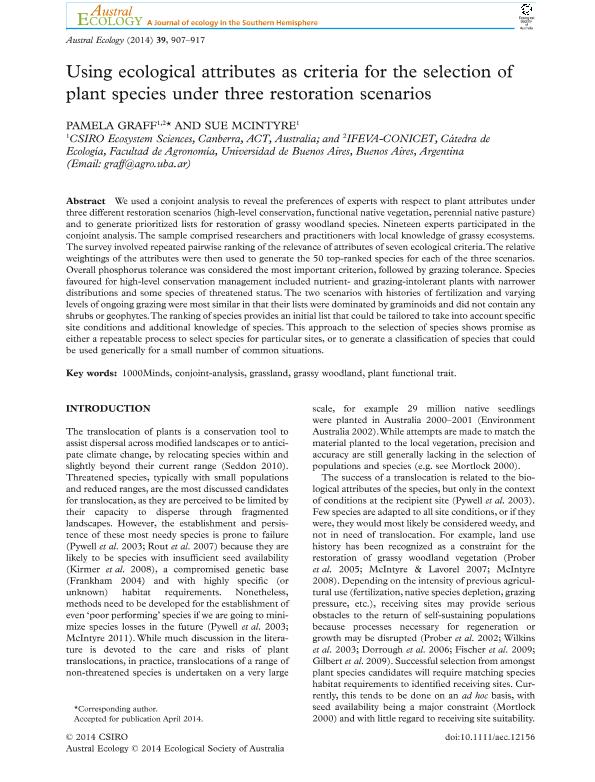Mostrar el registro sencillo del ítem
dc.contributor.author
Graff, Barbara Pamela

dc.contributor.author
McIntyre, Sue
dc.date.available
2016-02-17T20:51:53Z
dc.date.issued
2014-12
dc.identifier.citation
Graff, Barbara Pamela; McIntyre, Sue; Using ecological attributes as criteria for the selection of plant species under three restoration scenarios; Wiley; Austral Ecology; 39; 8; 12-2014; 907-917
dc.identifier.issn
1442-9985
dc.identifier.uri
http://hdl.handle.net/11336/4243
dc.description.abstract
We used a conjoint analysis to reveal the preferences of experts with respect to plant attributes under three different restoration scenarios (high-level conservation, functional native vegetation, perennial native pasture) and to generate prioritized lists for restoration of grassy woodland species. Nineteen experts participated in the conjoint analysis. The sample comprised researchers and practitioners with local knowledge of grassy ecosystems. The survey involved repeated pairwise ranking of the relevance of attributes of seven ecological criteria. The relative weightings of the attributes were then used to generate the 50 top-ranked species for each of the three scenarios. Overall phosphorus tolerance was considered the most important criterion, followed by grazing tolerance. Species favoured for high-level conservation management included nutrient- and grazing-intolerant plants with narrower distributions and some species of threatened status. The two scenarios with histories of fertilization and varying levels of ongoing grazing were most similar in that their lists were dominated by graminoids and did not contain any shrubs or geophytes. The ranking of species provides an initial list that could be tailored to take into account specific site conditions and additional knowledge of species. This approach to the selection of species shows promise as either a repeatable process to select species for particular sites, or to generate a classification of species that could be used generically for a small number of common situations.
dc.format
application/pdf
dc.language.iso
eng
dc.publisher
Wiley

dc.rights
info:eu-repo/semantics/openAccess
dc.rights.uri
https://creativecommons.org/licenses/by-nc-sa/2.5/ar/
dc.subject
1000minds
dc.subject
Conjoint-Analysis
dc.subject
Grassland
dc.subject
Grassy Woodland
dc.subject
Plant Functional Trait
dc.subject.classification
Conservación de la Biodiversidad

dc.subject.classification
Ciencias Biológicas

dc.subject.classification
CIENCIAS NATURALES Y EXACTAS

dc.subject.classification
Ecología

dc.subject.classification
Ciencias Biológicas

dc.subject.classification
CIENCIAS NATURALES Y EXACTAS

dc.title
Using ecological attributes as criteria for the selection of plant species under three restoration scenarios
dc.type
info:eu-repo/semantics/article
dc.type
info:ar-repo/semantics/artículo
dc.type
info:eu-repo/semantics/publishedVersion
dc.date.updated
2016-03-30 10:35:44.97925-03
dc.journal.volume
39
dc.journal.number
8
dc.journal.pagination
907-917
dc.journal.pais
Estados Unidos

dc.journal.ciudad
Hoboken
dc.description.fil
Fil: Graff, Barbara Pamela. Consejo Nacional de Investigaciones Científicas y Técnicas. Oficina de Coordinación Administrativa Parque Centenario. Instituto de Investigaciones Fisiológicas y Ecológicas Vinculadas a la Agricultura; Argentina. CSIRO Ecosystem Sciences; Australia
dc.description.fil
Fil: McIntyre, Sue. CSIRO Ecosystem Sciences; Australia
dc.journal.title
Austral Ecology

dc.relation.alternativeid
info:eu-repo/semantics/altIdentifier/url/http://onlinelibrary.wiley.com/doi/10.1111/aec.12156/abstract
dc.relation.alternativeid
info:eu-repo/semantics/altIdentifier/doi/http://dx.doi.org/DOI:10.1111/aec.12156
dc.relation.alternativeid
info:eu-repo/semantics/altIdentifier/issn/1442-9985
Archivos asociados
